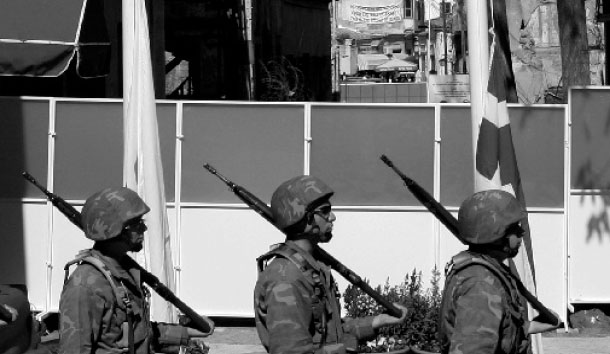In 1958, when the first barbed-wire barricades were rolled out by the British colonial government across Ledra Street in the capital of Cyprus, it seemed inevitable that the seeds of division would yield a bitter harvest of intercommunal conflicts, regional tensions, and, finally, the partition of the whole island.
Where minarets and churches once jostled happily together under the high, bright sun by day and crescent moon by night, garrisoned troops took up positions in machine-gun outposts and artillery turrets, effectively dividing the inhabitants of Nicosia—Turkish and Greek Cypriot—into two distinct ethnic groups.
Eventually, the age-old Greco-Turkish enmity found a new front line, as the Hellenic and Ottoman civilizations collided once again along the U.N.-patrolled Green Line dividing northern and southern Cyprus.
This past August, the leaders of the two ethnic communities, Mehmet Ali Talat and Tassos Papadopoulos, resumed discussions about the future of the island. Within the circles of the United Nations and the European Union, U.S. Undersecretary of State Nicholas Burns added his voice to the growing consensus of diplomats and heads of state calling for a swift and final resolution of the Cyprus problem.
With a visit to Cyprus planned in the near future, Mr. Burns is expected to express his government’s support for the most recent unification model—a bi-zonal, bi-communal federation. These recent conciliatory initiatives and overtures follow demolition work commenced last year on part of the wall that has divided Nicosia and the whole island since 1974.
When I visited Cyprus recently, Melissa, a traditional Greek-styled cake shop in an old quarter of Nicosia, was still serving Turkish coffee in the same way it had for decades. Kateifi, Paclava, and other freshly baked cakes and sweets filled window displays. Hand-embroidered white tablecloths covered the few rectangular tables where customers typically sat to enjoy their coffee. The day I was there, only a few customers came in and seemed to pick up regular orders of sweets.
Before the erection of the barriers and partition of the island, Melissa was a perpetual hub of social life, where the street outside bustled with bicycles, pedestrians, and taxi-cabs. In recent years, however, the view from its gilded window frames has been starkly different.
The streets are empty now. A rusty bicycle leans against a lamppost. Solitary figures occasionally emerge from dilapidated workshops that occupy the grand old buildings where boutiques once operated. Grass tussocks have sprouted around the ramshackle brick barriers and between the sandbags filling the windows of the surrounding old Venetian-styled buildings.
Crumbling walls display the faded markings of political slogans from long-forgotten campaigns. Once buzzing with conversations about coup d’état, the military junta, and self-determination, sagging electrical wires that run from pole to pole look as if they have been gripped by a creeping paralysis. In fact, the whole area seems to have been suspended in time like a Hollywood backlot from a film from yesteryear.
My father, born in Cyprus in 1926, has fond memories of many hours spent in coffeeshops with Turkish and Greek Cypriot friends. As an electrician working for the Paphos Electrical Station (now a museum), he recalls three Turkish Cypriots with whom he had a close friendship. Some of the Turkish Cypriots joined him when he decided to migrate to Australia.
On my father’s forearm is a faded tattoo of a sailing ship and the words “Cyprus to Australia 1951” in a pennant under the image. The small group of friends—Greek and Turkish Cypriot—all had the same tattoo pierced onto their forearms to commemorate their epic journey. As a boy, I was fascinated by the likeness of the tattoos when the group would meet. As the years passed, the tattoos faded, and the group dwindled in size. Today, my father and one other man, a Turkish Cypriot, survive.
For my father, Cyprus was never divided. Greek Cypriots and Turkish Cypriots were never at war. After all, when he lived in Cyprus, there was a high degree of cohesion and integration between the two ethnic groups. This is how he left Cyprus and always remembered it.
In reality, when the yoke of colonial rule was finally shrugged off in 1960, the responsibility of forming a government representing both ethnic populations was great. The geopolitical ambitions of the United States and Britain in the Middle East, and the posturing of Greece and Turkey over territorial sovereignty in the Mediterranean, contributed significantly to intercommunal tensions. As the two communities drifted further apart, ethnic enclaves grew as integrated villages fell in number. In time, Nicosia was divided by a wall.
Last year, the wall started to come down. While the demolition work was centered only on a small part of the boundary of the historic Old City, it still had profound symbolism. Although official efforts to unify Cyprus have failed, on a municipal level, Greek and Turkish Cypriots have been cooperating for years toward preserving and restoring the rich Ottoman, Venetian, and Lusignan heritage of the Old City.
The demolition work paved the way not only for the opening of a pedestrian bridge on Ledra Street, a once-thriving commercial center, but also for the recent talks in Nicosia between the two community leaders.
Ledra Street was where the first barbed-wire barricades were rolled out. A small pedestrian bridge has not only brought two commercial districts together but made foreseeable a new and old horizon: the reunification of a divided city, an island, and the hearts and minds of all Cypriots.

Leave a Reply